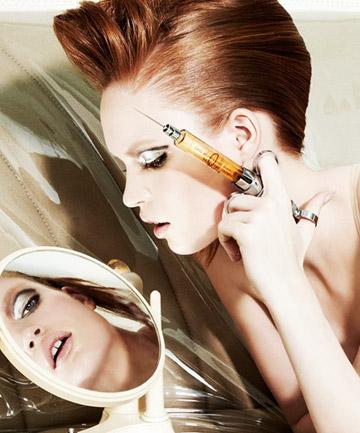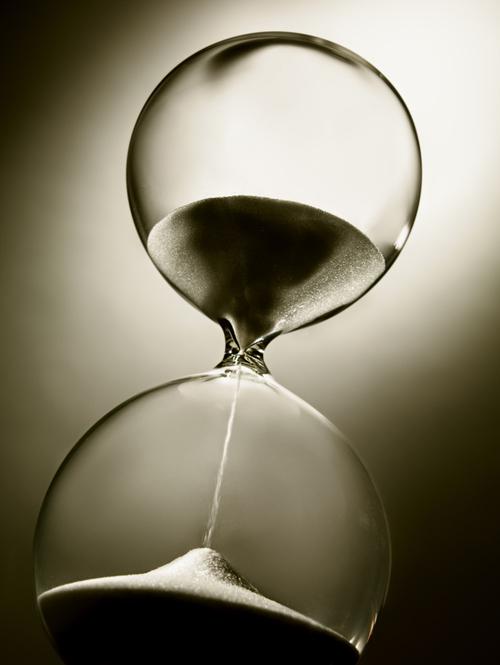- share on facebook
- pin it
- share on google+
Jennifer Lopez, 45, is only eight months older than I am. Her twins were born less than a year after mine. We are both female humans who live in Los Angeles. Neither one of us wants to look old. This is where our similarities end.
Have you seen the photos of Lopez leaving Tracy Anderson’s gym, with her shirt half-off (oops!) to expose the carved six-pack of a 22-year-old CrossFit instructor? Have you happened to notice her lineless, spotless skin? If you caught her infamous “Booty†video with Iggy Azalea, you know that her perfect complexion doesn’t stop at the neck.
Now, let the record show, I’m holding up pretty well. I’ve earned plenty of Amex points from my skincare habits, which include the occasional micro-current facial, intense pulsed-light treatment, and prescription cream. People regularly look surprised when I reveal my ageâ€"though they could just be in shock that I divulge it so freely. But I’d be lying if I didn’t cop to wondering (sometimes aloud, in front of the mirror), Why am I not aging like J. Lo, or Gwyneth, or Sandra, or…(insert the name of your favorite celeb here)?Â
“I have this conversation 10 times a day with patients,†the Manhattan dermatologic surgeon Dendy Engelman declares. “They’ll say, ‘I work out. I’m vegan. I don’t drink alcohol. I drink lots of water. Why do these actresses still look so much better than I do?’ And I can tell you, because I treat a lot of them: Anyone who looks like that and says she hasn’t done any kind of enhancement isn’t telling the truth.â€
That’s not really news, but in the last decade, the “enhancement†game has changed. A 40-something actress might not be going under the knife for a major overhaul, but chances are she is doling out for frequent minor tune-ups, which can be even more effective at stopping the clock. So when Lopez took to Twitter last year to denounce claims that she’s “had plastic surgery of any kind,†she might well have been telling the truth. The fact is, with the nonsurgical treatments available now, she hasn’t had to.
Still, that’s not to say that the quest to remain 33 forever is a walk in the park; it’s more like a marathon. To “mature†like a celebrityâ€"say the dermatologists and cosmetic surgeons who treat themâ€"requires a degree of commitment, in terms of both money and time, that mere mortals might find unreasonable, if not insane. “One patient who is an on-air personality spends $6,000 every two weeks,†Engelman confides, adding that it’s not unusual for patients to cough up $25,000 to $50,000 annually, not on a full swanlike transformation, but just to look like the best version of themselves.
For some perspective on how our perception of aging has changed, consider the following: Sandra Bullock, 50, has never looked better. Conversely, Ann B. Davis, the recently deceased actress who played Alice, the matronly housekeeper, on The Brady Bunch, was just 42 when she was cast on the show. Jean Stapleton was roughly the same age as Julia Roberts is now (47) during the first season of All in the Family, and Sally Field was 42 when she played Roberts’s mother in Steel Magnolias.
Part of this shift is due to the fact that our culture is allowing women to be sexy and youthful into their 40s, 50s, and 60s without judgment. But, according to Harold Lancer, the Beverly Hills dermatologist who treats Beyoncé and Scarlett Johansson, the seismic change in how women in the spotlight age has less to do with society than it does skincare: Actresses in their 40s today were part of the first generation to commit to sunscreen and Retin-A in their 20s. Apparently, if you want to look good when you are 44, you need to start working at it when you are 24â€"or younger.Â
“Dakota Fanning was 9 when she first walked into my office,†Lancer says. “I make sure my patients of any age understand the value of exercise, avoiding carbohydrates, salt, and dairy. Then I start them on a skincare routine. After two weeks, we reevaluate, and they’ll have microdermabrasion. At six weeks, we’ll try ultrasound or radiofrequency to lift the neck, cheekbones, and brows. Needles are considered at about three months in. My clients aren’t just in it for a quick fix. They understand that they’re starting a cycle of chronic and expensive maintenance. There’s no such thing as planting agarden that doesn’t need weeding.â€
Among the more effective weed killers available is Botox, the neurotoxin that some derms are now injecting well before deep wrinkles show up. “I use it in the whole face, and do it lightly, so you retain expressions but don’t have lines at rest,†says Santa Monica dermatologist Karyn Grossman. “If the lines are still deeper than what patients want, I’ll inject a bit of the fine-line filler Belotero Balance.†As for undereye filler, she says, “actors don’t wait until the hollows are bad to fix them. Normally, their director of photography will say something about it sooner rather than later.â€
Injectables are still the dermatologic indulgence that everyone likes to deny. Over-filled lips, a puffed-out “monkey mouth,†and inflated cheekbones are so stigmatized that we only see them on Bravo. But the truth is that A-listers are still filling up, and doing so frequently. It’s just harder to discern because fillers such as Belotero, which many celebrity dermatologists seem to favor, can be administered in microdroplets with a tiny needle, resulting in a more natural look. Perhaps that’s why they’re being used to restore volume in areas that were rarely considered before, like around the temples. Grossman even injects earlobes that have been overstretched by years of heavy Harry Winstons. “And I’ll inject filler into the hands and forearms of patients who are very thin, because that can make a person look much older,†she adds.
Engelman, who has been known to use injections to tackle cellulite dimples, tells a similar story: “I just put filler in someone’s knees, and she’s not even famous!â€
Some of the most dramatic advancements in skincare, however, have been in the realm of tightening and firming. Ultrasound treatments (like Ultherapy), radiofrequency therapy (like Thermage), and gentler lasers (like Clear & Brilliant) are making it possible to restore texture and tone quickly and with minimal recovery time. Lancer says that the most “social downtime†any of his Hollywood patients can tolerate is about three days, so they opt for less-ablative lasers with shorter gaps between sessions. Radiofrequency, meanwhile, requires little to no time away from the spotlight, making it an attractive choice for red carpet regulars. “Gwyneth is very open about how much she loves Thermage,†Grossman says. “It keeps the skin thick, and I like to keep my patients’ skin thick as long as possible.â€
When stars aren’t at the dermatologist’s, chances are they’re getting facialsâ€"very high-tech facials. Microcurrent machines that temporarily stimulate muscle tone are now as common as steamers among top aestheticians, as are light-emitting diode (LED) treatments, which speed regeneration and impart a multi-day glow in just 20 minutes. “I use LED lights, ultrasound, microdermabrasion, and oxygen,†says the Los Angeles facialist Cristina Radu, who treats Cindy Crawford, among others. “I tell new clients that if we do a ‘boot camp’ of four facials in a row, three weeks apart, we’ll see big changes.â€Â
New York microcurrent pioneer Joanna Vargas’s Triple Crown facials cost $400 a pop, and her regulars come in weekly. The lifted look that results lasts several days, and the idea is to “wake up†the muscles continually so they tightenâ€"like Pilates for the face. “I do my best work when I can treat people over a period of time,†says Vargas, who boasts Rachel Weisz, Julianne Moore, and Naomi Watts as devotees.Â
It’s an intensive regimen by any definition: If you start weekly LED treatments, biweekly facials, and quarterly Botox in your early 30s and then build up to biannual Thermage or Ultherapy, biannual filler, and the occasional laser treatment, you have a chance of looking like J. Lo at 45. And the results will be so gradual that nobody will raise an eyebrowâ€"important now that an alleged eyelift is considered headline news by CNN (our condolences, Renée). But, perhaps in the name of sisterhood, some stars are starting to admit that looking like a million bucks costs about that much too.Â
Sofia Vergara, 42, has been comically open about the time she clocks at Engelman’s and Lancer’s offices. Gwyneth Paltrow’s candidness about going in for “little things, like lasers†is a breath of fresh air. And just when you thought Robin Wright couldn’t be more likable, she admitted in an interview last year to a twice-annual “sprinkle of Botox,†adding, “Everybody f***ing does it.â€
But, according to Grossman, it would take more than a “sprinkle†of anything for an antiaging dabbler like myself to catch up. After scrutinizing my skin in her pristine office, she delivers her verdict. In order to work toward an actress-caliber complexion, I’d need to start with Thermage for both my face and neck; Restylane for under my eyes; Dysport (a neurotoxin) for around my eyes and in my brow, chin, and upper lip; Fraxel on my neck and chest; laser skin rejuvenation; and a little Belotero to fill in the lines that Dysport can’t. The price tag: over $16,000 to begin, and that doesn’t include skincare. My immediate response is, Thank God I am not an actress. For now, at least, I will save my money for private-school tuition and the occasional vacation, after which my eyes might look better because I will be actually rested. Says Grossman, “I have patients who spend $30,000 a year and look great, and I have patients who spend $3,000 a year who look great. It’s not just about wrinkles.†It’s also about how you define “great.â€Â









